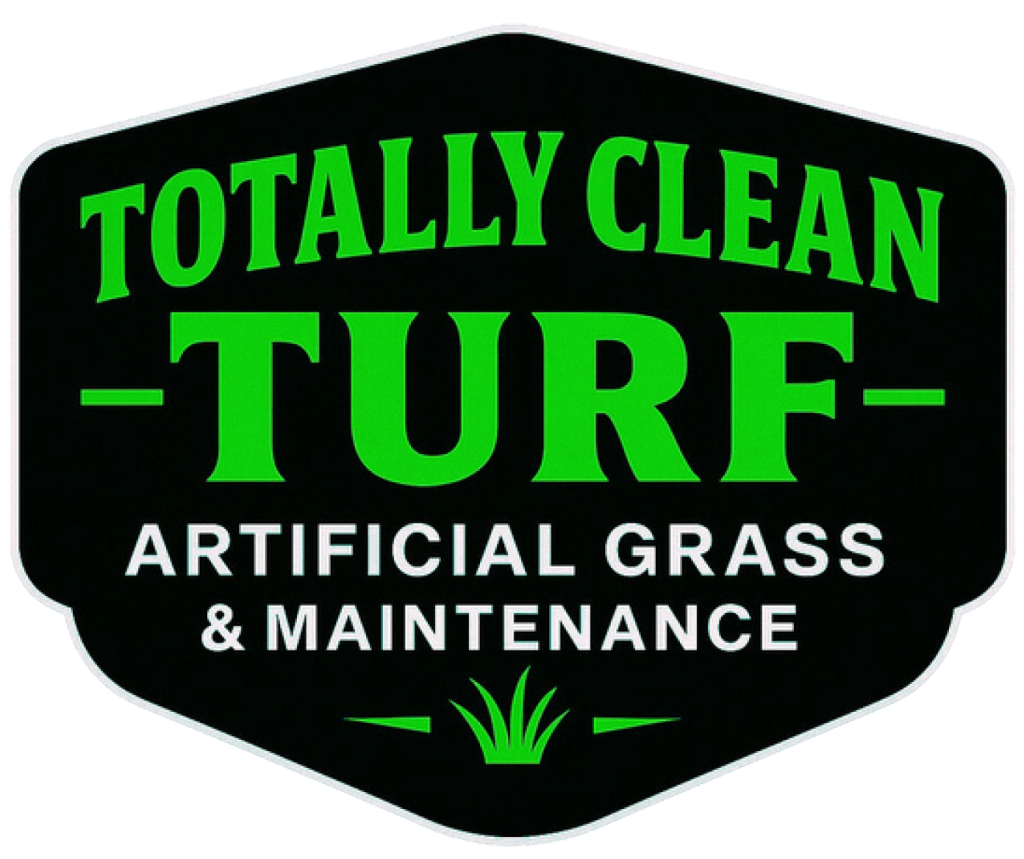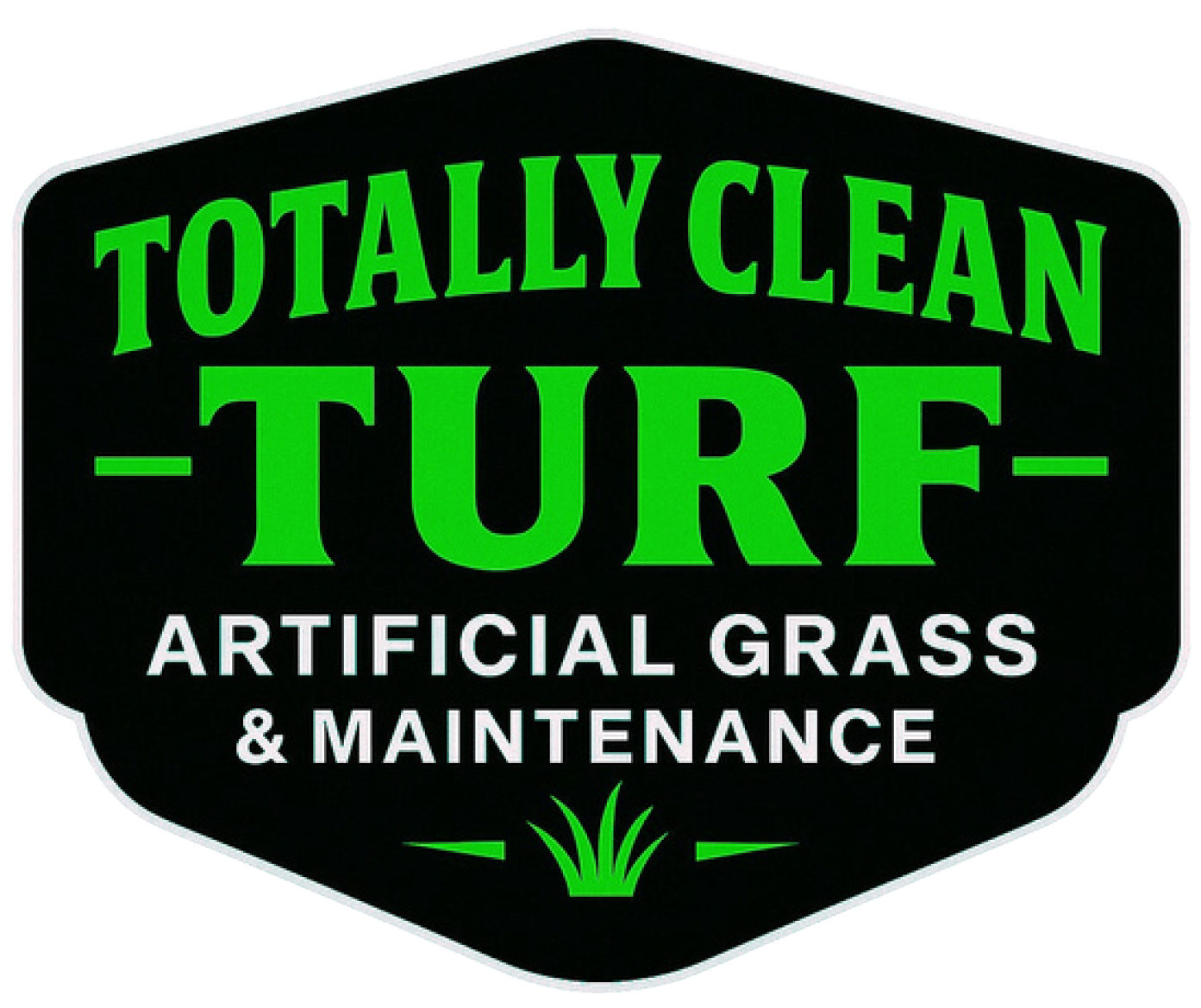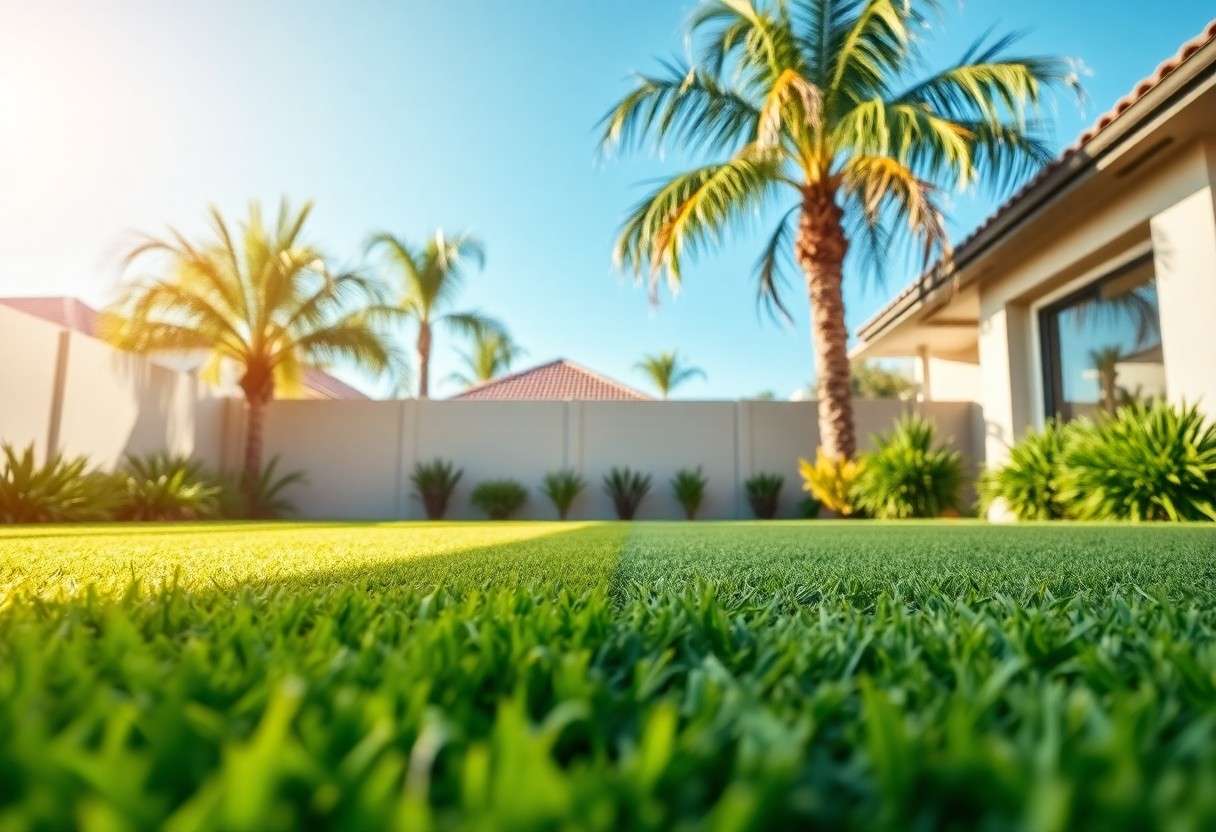Artificial grass offers a modern alternative to natural lawns, especially suited to the Inland Empire’s unique climate challenges. When deciding between artificial and real grass for your property, you’ll want to weigh factors like water usage, maintenance needs, durability, and environmental impact. This guide helps you understand the benefits and drawbacks of each option, empowering you to make an informed choice that fits your lifestyle, budget, and landscaping goals in this particular region.
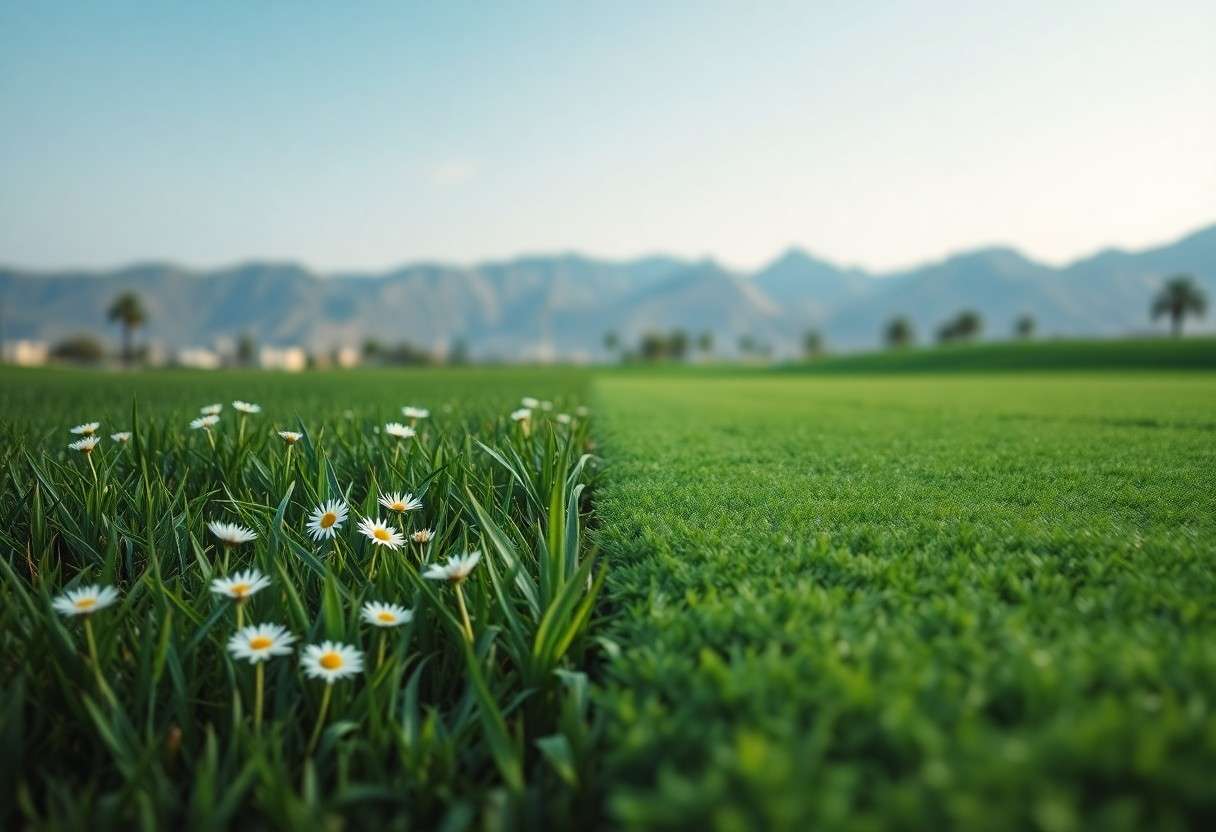
Key Takeaways:
- Artificial grass offers significant water savings and low maintenance, making it ideal for the Inland Empire’s dry climate and water restrictions.
- While real grass provides natural cooling and a traditional aesthetic, it requires frequent watering, mowing, and upkeep, which can be costly and time-consuming in this region.
- Artificial turf is pet- and family-friendly with options for odor removal and sanitizing, but it may have a higher upfront installation cost compared to natural lawns.
Water Conservation and Environmental Impact
Water scarcity shapes landscaping choices in the Inland Empire, making water efficiency a major factor. Traditional lawns consume vast amounts of water—up to 55 gallons per square foot annually—while artificial grass slashes this demand to nearly zero. Beyond watering, synthetic turf eliminates the need for pesticides and fertilizers, reducing harmful runoff. You benefit from a vibrant lawn year-round, without straining local water resources or contributing to pollution, aligning well with the region’s growing eco-conscious mindset.
The Dwindling Water Supply in the Inland Empire
The Inland Empire faces persistent drought conditions that challenge water availability for landscaping and households alike. With groundwater levels dropping and stricter water restrictions imposed, homeowners must rethink traditional irrigation-heavy lawns. Local utilities increasingly promote water-saving alternatives, especially amid hotter, longer dry seasons. If you maintain a natural grass lawn, expect rising water bills and potential limits on irrigation, pushing many to explore sustainable turf solutions that ease the burden on our fragile water supply.
Artificial Grass as a Sustainable Alternative
Artificial grass offers a practical response to water scarcity, using zero irrigation once installed, which can save thousands of gallons annually in your yard. Beyond conserving water, the latest turf products use recyclable materials and UV-resistant fibers that extend lifespan, reducing landfill waste. Installation also circumvents chemical fertilizers and herbicides, supporting local groundwater health. For you, this means a consistently lush appearance with minimal environmental footprint, making it a smart choice for eco-conscious residents across Riverside and San Bernardino counties.
Adding to its sustainability, artificial turf’s reduced maintenance translates into less reliance on gas-powered mowers and leaf blowers, further cutting carbon emissions. Advanced drainage systems integrated during installation prevent water runoff problems common with compacted soils in natural lawns. Totally Clean Turf specializes in eco-friendly installations tailored to Inland Empire’s climate, ensuring optimal performance and durability. By choosing synthetic grass, you join a growing movement toward conserving water while maintaining beautiful, usable outdoor spaces for pets, kids, and family enjoyment.
Cost Analysis: Upfront and Long-Term Investments
Your decision between artificial and real grass often hinges on balancing initial expenses with ongoing costs. Artificial turf demands a higher upfront investment due to material and professional installation fees, but it typically saves money over time by cutting out water bills, fertilizers, and mowing expenses. Real grass installations may start more affordable but involve recurring costs like irrigation, lawn care, and seasonal treatments. Understanding these financial dynamics helps you plan smartly for both your wallet and lifestyle.
Installation Costs: Comparing Initial Outlays
Installation Costs Comparison
| Artificial Grass Installation | Real Grass Installation |
|---|---|
| Materials and labor average $8–$15 per sq. ft. | Soil preparation and sod or seed average $1.50–$3.50 per sq. ft. |
| Requires professional installation for optimal drainage and lifespan | Can be DIY or professional; simpler upfront but ongoing soil amendments needed |
| Includes base layering and infill for durability | Cost varies with seed quality and sod type |
Artificial turf installation from a trusted provider like Totally Clean Turf ensures quality materials and skilled professionals but comes with a steeper upfront price. Real grass installation feels less costly initially but often requires more frequent repairs and replacement over time.
Maintenance Expenses: Budgeting for Longevity
Maintaining real grass involves regular watering, mowing, fertilization, weed control, and occasional reseeding, which add up to hundreds annually depending on lawn size. In contrast, artificial grass maintenance focuses on periodic cleaning and specialty services like turf decompaction, odor removal, and turf blooming offered by companies such as Totally Clean Turf. These services, while less frequent, help preserve turf longevity and appearance, saving you long-term costs and time.
With real grass, expect ongoing expenses from irrigation systems, fertilizer, and pest control, which can average $500-$1,200 yearly on a typical residential lawn in the Inland Empire. Artificial turf eliminates most of these costs but requires specialized upkeep to prevent fiber matting and odor buildup—especially if you have pets. Utilizing comprehensive maintenance programs like those provided by TCT helps maintain the plush, vibrant look of synthetic turf while keeping it sanitized and odor-free, making it a cost-effective solution over its 10-15 year lifespan.
Aesthetic Appeal and Practical Functionality
Your choice between artificial and real grass impacts not only how your lawn looks but how it performs day to day. Synthetic turf offers consistent greenery year-round, resisting brown spots or patchiness common with natural grass in Inland Empire’s hot, dry climate. Meanwhile, real grass can provide organic texture and seasonal color changes that some find more visually appealing. Balancing natural beauty with practical benefits depends on your priorities and site conditions.
Visual Aspects: Natural vs. Synthetic Beauty
Natural grass delivers an authentic, vibrant appearance with varied shades and gentle movement in the breeze. However, synthetic turf from Totally Clean Turf mimics this lush look with carefully designed fibers that retain upright posture and rich color without fading. Modern artificial grass also avoids the muddy spots or yellowing often seen during heat waves or irrigation issues, keeping your lawn picture-perfect throughout the year.
Performance Under Pressure: Durability and Usage
Artificial grass stands up well to heavy foot traffic, pet activity, and play areas, retaining its shape without bare patches or dirt spots. Synthetic turf doesn’t require rest periods like natural grass and resists damage from frequent use, making it ideal for busy residential backyards or commercial spaces in Riverside and San Bernardino counties.
Real grass tends to suffer in high-traffic zones, leading to worn-out patches and soil compaction that require time and resources to repair. Artificial turf’s durability comes from resilient polyethylene fibers and strong backing materials, designed to endure year-round use without degradation. Maintenance services like turf decompaction and turf blooming, offered by Totally Clean Turf, help restore softness and appearance even after intensive use, extending your investment’s lifespan and keeping your lawn functional and attractive.
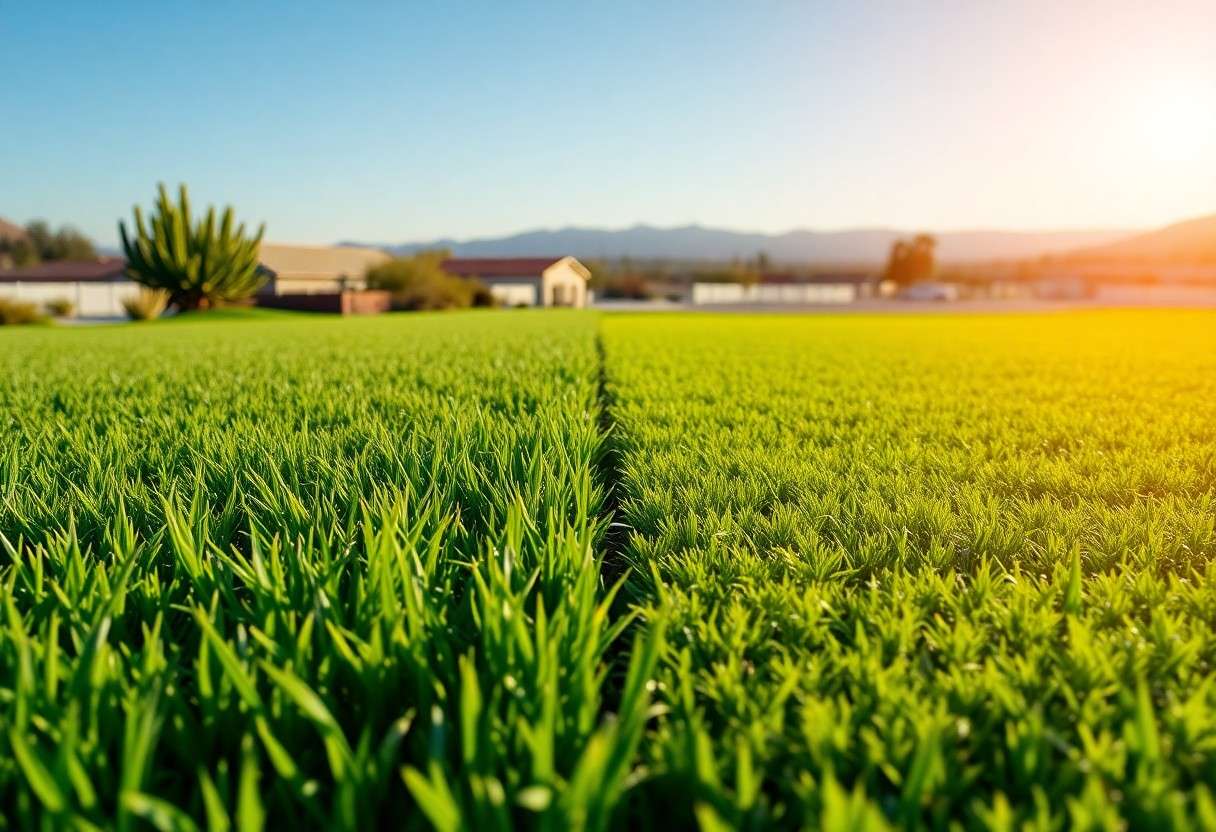
The Health and Safety Factor
Both artificial and real grass present unique health and safety considerations that can affect your family’s wellbeing. Real grass can harbor pollen and insects, while synthetic turf may retain heat and sometimes trap bacteria without proper upkeep. Choosing artificial grass with professional installation and ongoing turf sanitizing services, like those offered by Totally Clean Turf, helps maintain a clean, safe surface that’s especially beneficial in sunny Inland Empire climates.
Allergen Concerns: Real Grass vs. Artificial Turf
Real grass naturally produces pollen, which can trigger allergies during certain seasons, affecting your comfort outdoors. Artificial turf eliminates pollen-related allergens but may accumulate dust and debris that require regular turf cleaning to avoid irritation. You’ll find that with scheduled maintenance, including turf deodorizing and sanitizing, synthetic options offer a hypoallergenic alternative that supports healthier outdoor activity, especially for sensitive family members.
Safety for Kids and Pets: A Closer Look
Artificial grass installations designed for families and pet owners provide surfaces free from pesticides, mud, and uneven spots that can cause injuries. Turf sanitizing treatments reduce bacteria and odors, creating a cleaner play environment for kids and pets. However, synthetic turf can absorb more heat, so you’ll want to consider heat-resistant materials and proper maintenance to keep the surface comfortable and safe year-round.
Experts like Totally Clean Turf recommend their turf decompaction and blooming services to preserve softness and drainage, preventing hard or compacted areas that might pose tripping hazards for children and discomfort for pets. Combined with regular odor removal and sanitizing, artificial grass can outperform real lawn areas in cleanliness and safety, particularly when you prioritize professional installation and upkeep that consider your household’s active lifestyle.
Community Perception and HOA Regulations
Growing acceptance of artificial grass in the Inland Empire reflects changing community attitudes as more homeowners appreciate its water-saving and low-maintenance benefits. However, navigating HOA guidelines remains a key step, as some associations maintain strict rules to preserve neighborhood aesthetics. Understanding local ordinances and gathering HOA approval can smooth the installation process, ensuring your synthetic lawn meets community standards while delivering lasting value and curb appeal.
Changing Attitudes Towards Artificial Grass
Increasing drought concerns and rising water costs have shifted many Inland Empire residents toward synthetic turf. Homeowners now value artificial grass for its realistic appearance and eco-friendly advantages, particularly in pet areas and children’s play zones. This shift is also reflected in community discussions, where artificial lawns have moved from being stigmatized to commonly recommended solutions for sustainable landscaping.
Navigating HOA Approval for Synthetic Lawn Installations
HOA regulations can vary widely, with some associations requiring detailed applications, including samples or photos of the artificial grass. To secure approval, you may need to demonstrate the turf’s quality, color fidelity, and installation professionalism. Early communication with HOA boards and providing detailed plans can expedite permissions and avoid costly revisions during or after installation.
Several HOAs in Riverside and San Bernardino counties now permit artificial grass if it meets standards on texture, color, and maintenance. Presenting certification from licensed installers like Totally Clean Turf, along with maintenance plans emphasizing odor control and turf sanitizing, strengthens your case. Keeping detailed records of turf decompaction and blooming treatments further reassures HOAs of your commitment to preserving lawn quality. Proactively addressing typical concerns such as glare, drainage, and uniformity helps you navigate possible restrictions effectively.
Conclusion
Conclusively, when deciding between artificial grass and real grass in the Inland Empire, you benefit from low maintenance, water-saving landscaping, and durability with synthetic turf, perfect for your busy lifestyle and dry climate. However, you may miss the natural feel and biodiversity real grass offers. While real grass requires regular watering and upkeep, it supports local ecosystems. Understanding these pros and cons helps you make an informed choice that best fits your needs, whether prioritizing convenience, environmental impact, or aesthetic preferences for your property.
FAQ
Q: What are the main advantages of choosing artificial grass over real grass in the Inland Empire?
A: Artificial grass offers several benefits in the Inland Empire, including significant water savings due to its drought-resistant nature, which is ideal for the region’s dry climate. It requires minimal maintenance—no mowing, fertilizing, or pest control—making it a low-maintenance lawn solution. Additionally, artificial turf provides a consistently green and plush appearance year-round, regardless of weather conditions or seasonal changes.
Q: Are there any downsides to installing artificial grass compared to natural grass in this area?
A: While artificial grass eliminates many maintenance tasks, the initial installation cost can be higher than seeding or sodding natural grass. Some people may find that artificial turf gets hotter under direct sunlight, which can be uncomfortable during peak summer months typical of the Inland Empire. Also, artificial grass does not support natural soil ecosystems and may require occasional cleaning and sanitizing to manage pet odors and debris buildup.
Q: How does artificial grass impact environmental concerns compared to real grass in the Inland Empire?
A: Artificial grass helps conserve water resources, a significant environmental benefit given the Inland Empire’s frequent drought conditions. It also reduces the need for chemical fertilizers and pesticides, lowering chemical runoff into local ecosystems. However, synthetic turf is made from plastics and other materials that may not be biodegradable. Proper disposal and recycling at the end of its lifespan are important for minimizing environmental impact.
